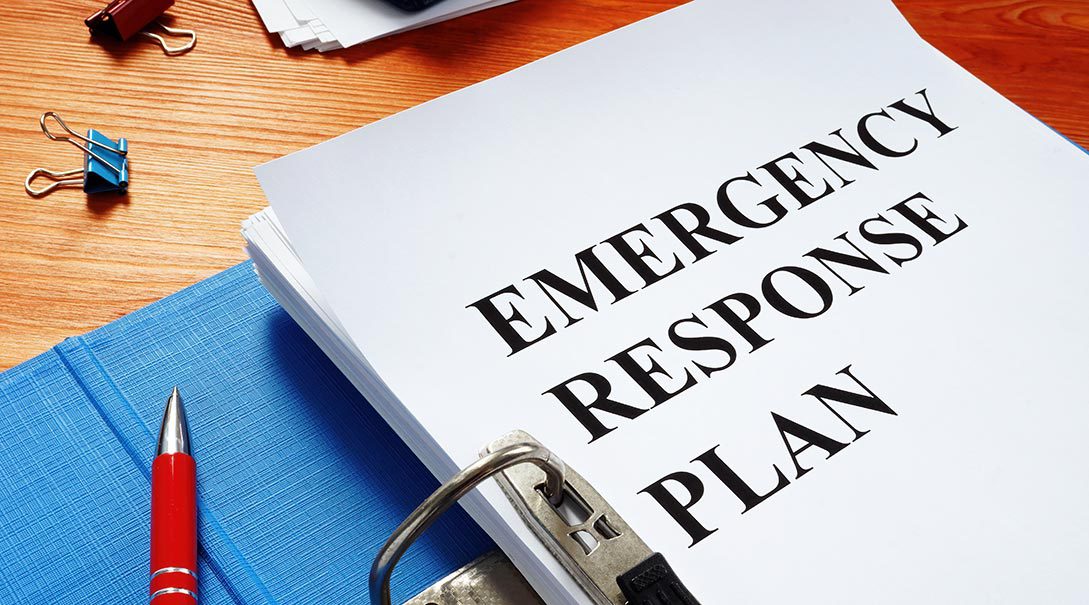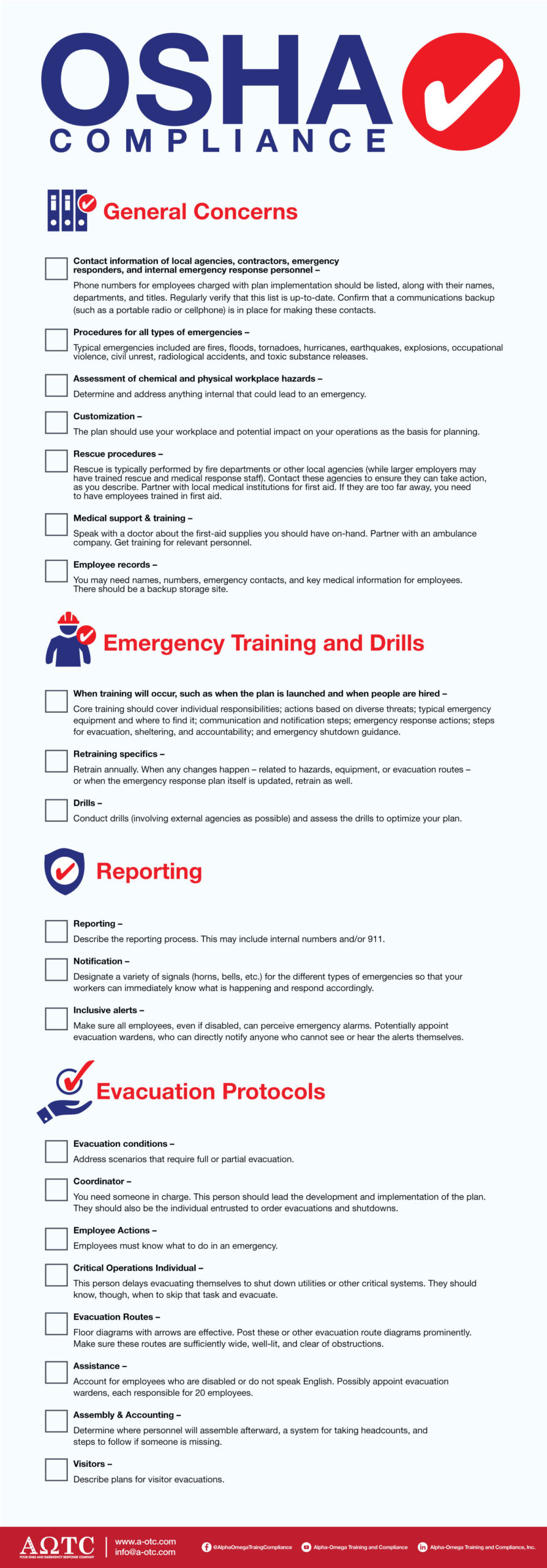Preparation is critical to your business. While you certainly cannot plan for everything specifically, you can be ready for anything broadly. When it comes to protecting your workers and remaining OSHA compliant with the federal Occupational Safety and Health Administration (OSHA), you need to know what you will do in potentially dangerous worst-case scenarios. This forward-thinking is in the realm of emergency preparedness and emergency response. With a specific emergency response plan, OSHA regulations can be addressed systematically.
Emergencies must be carefully considered because they present diverse hazards within your workplace. It is particularly important to know what you will do under the most difficult circumstances because you may need to move without stopping to think over your strategy. Strong emergency preparedness sets you up for the best emergency response so that everyone associated with your business has a safe place to go and access to protective equipment.
To make your employees aware of the risks they might face in emergencies, you need an emergency action plan (EAP). This document covers evacuation procedures, employee training, and other elements of preparedness and helps you avert or mitigate disasters when faced with unwelcome events.
Table of Contents
What Is A Workplace Emergency?
Emergency scenarios in the workplace fall into two basic categories, those generated by people and by the environment.
Types of emergencies resulting from people include:
- Trauma or injury caused by worksite violence;
- Civil unrest;
- Radiological accidents;
- Releases of toxic gas;
- Chemical spills; and
- Explosions.
Environmental emergencies could be any natural disaster, such as the following:
- Fires;
- Floods;
- Tornadoes;
- Hurricanes; and
- Earthquakes.
How can you identify other kinds of workplace emergencies? These incidents are unanticipated events that cause any of the following problems:
- Interference with or disablement of your operations;
- Introduction of a threat posed to the public, your customers, or your personnel; and/ or
- Damage, whether bodily or to the natural environment.
What Is An Emergency Response Plan (EAP)?
An emergency action plan (EAP) is a written document that is intended to organize and support the actions you and your employees take during on-the-job emergencies.
According to federal regulations, an EAP is mandatory for OSHA compliance. However, those with small businesses may be able to simply talk with personnel about the plan rather than have it in writing (see the next section).
Small Business: The Oral Emergency Response Plan
The good news for small companies with up to ten (10) employees is that you are not legally required to create a written report. Instead, you can simply speak with your workers and let them know what to do when various emergency situations arise (covering the topics in the below checklist). It may make sense to write everything down for organization and consistency, but it is not mandatory that you have an official document.
Why Is An OSHA Emergency Action Plan And Training Important?
Simply put, a well-developed emergency preparedness plan can save lives and save your business.
If you either do not have a plan or have not developed it well, that can cause confusion. If people are unsure of what to do when they are more susceptible to injury, death, and property damage from a disorganized emergency response.
On the other hand, if your workers know what to do when any type of emergency occurs, you are less likely for people to get hurt and die; plus, you are less likely to see damage to your workplace.
An excellent plan is well-integrated with OSHA training. As with other safety and health information, it is important that everyone on your payroll gets thorough training so that everyone knows what is expected of them when unforeseen circumstances arise.
OSHA Requirements
A comprehensive assessment of your workplace is essential and a basic building block of OSHA emergency preparedness. Using what you glean from your evaluation, you are able to consider the characteristics of your unique setting – its emergency systems, structure, and layout – and understand what the employee response should be to any conceivable event. This information allows you to easily and straightforwardly develop and implement a customized emergency action plan.
Here is what you need to have in your EAP, per OSHA regulations:
- Reporting protocols for any emergency;
- Names and/or titles of individuals who should be alerted;
- Assignments of escape routes and step-by-step procedures for evacuation;
- Medical and rescue procedures to be used by appointed employees;
- Confirmation that all personnel are present following an evacuation; and
- Steps to be taken by those on your staff who will stay behind to complete critical work prior to evacuation.
OSHA Recommendations
First and foremost, you want to get buy-in from everyone. If some of your employees are not aligned with this effort, it can create weaknesses in your emergency preparedness. To create a plan that is widely acknowledged and accepted, OSHA suggests using a collaborative model.
Organize a committee of both employees and management to develop and launch your emergency response plan. Have this team get together on a regular basis to refine the plan and determine which parties will advance various aspects.
Second, there are additional components that you may want to include in your emergency response plan:
- Information regarding a different communications center can be used if an explosion or fire occurs.
- Details about public address systems, sirens, horn blasts, and/or other aspects of your alarm system to be used in emergencies. These systems notify your workers that they need to evacuate or otherwise respond to an emergency. You want to have different sounds for each main type of emergency so your employees quickly get signaled what is happening. These notifications should take special consideration for any disabled personnel.
- A safe and secure storage area (whether onsite or offsite) so that copies or originals of core records – legal paperwork, accounting documents, emergency contact information for employees, etc. – can be accessed regardless of the situation. (Offsite storage is preferable, so there is less of a threat to both sets of copies.)
OSHA EAP Checklist
For an effective emergency response plan, OSHA stresses the importance of trained personnel. It is also important that employees get training updates whenever the OSHA EAP checklist is changed.
With this OSHA EAP simple checklist, you can put together a plan that is aligned with OSHA compliance and that will provide the most robust emergency preparedness:
Common Mistakes in Developing an Emergency Response Plan
We will now break down some common mistakes in developing an emergency response plan.
Lack of Specificity: A one-size-fits-all approach does not work for emergency response plans. Each workplace has unique hazards, requiring tailored plans that address specific risks, from chemical spills to natural disasters. Neglecting to customize your plan can result in inadequate responses that increase risk during an emergency.
Insufficient Training: Merely having an emergency response plan on paper is not enough. A common oversight is failing to provide comprehensive training for all employees, including regular drills and updates. Without thorough training, employees may not know how to act swiftly and safely in an emergency.
Poor Communication Strategies: Effective communication is crucial in emergencies. Plans often lack clear, multiple-channel communication strategies for alerting employees about an emergency and providing ongoing updates. Overlooking the need for diverse communication methods can lead to confusion and panic.
Neglecting Special Needs and Accommodations: Not considering the diverse needs of all employees, including those with disabilities, is a significant oversight. Plans should include provisions for assisting individuals with mobility, visual, hearing, or cognitive impairments during evacuations and other emergency procedures.
Inadequate Identification and Analysis of Risks: Some businesses fail to conduct a comprehensive risk assessment, overlooking potential threats. Understanding all possible emergencies, including less obvious ones like cyber-attacks or power outages, is essential for developing an effective response plan.
Failure to Regularly Review and Update the Plan: Emergency response plans are often created and then forgotten. Failing to review and update your plan regularly to reflect changes in your operations, workforce, or external environment can render it obsolete when an emergency occurs.
Ignoring Community Resources and External Partners: Many businesses overlook the importance of coordinating their emergency response plan with local emergency services, neighboring businesses, and community resources. Collaboration can enhance your response capabilities and provide additional support during and after an emergency.
Inadequate Backup and Recovery Plans: Ensuring business continuity involves more than just an immediate response. A common error is not having a robust recovery plan to resume operations safely after an emergency. This includes data backups, alternative work sites, and supply chain contingencies.
Not Testing the Plan Thoroughly: Without conducting full-scale drills that simulate real emergency scenarios, it’s difficult to identify weaknesses in your plan. Many businesses fail to test their plans adequately, missing the opportunity to refine procedures and ensure all employees are prepared.
By avoiding these common mistakes, businesses can develop a comprehensive, effective emergency response plan that not only complies with OSHA regulations but also significantly enhances the safety and preparedness of their workplace. This proactive approach is essential for protecting employees, minimizing risks, and ensuring a swift recovery from any emergency situation.
Refining Your Emergency Preparedness Plan
Finally, it is critical to review and update your emergency response plan, not just when your environment changes but also at regular intervals. Pay special attention to the contact information – the most commonly outdated item, per OSHA.
For your emergency response plan, OSHA compliance efforts, and potential evacuations to be successful, occupational health and safety training is pivotal. At Alpha-Omega Training and Compliance (A-OTC), we assess your business needs and work with you to devise a customized program. Contact us to schedule your training and education courses or environmental consulting services today! We also offer 24/7 emergency spill response services.
Sources

